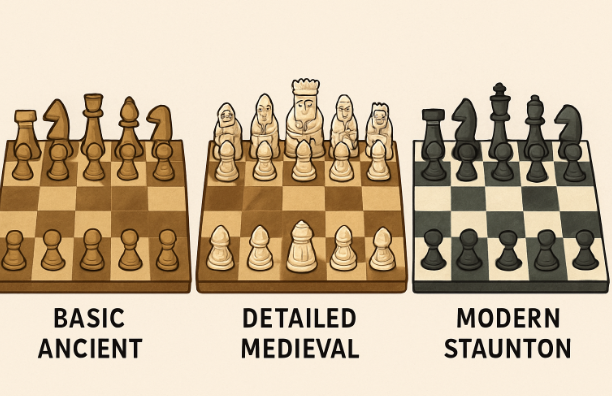Introduction
For centuries, the design and craftsmanship of chess sets have offered a unique window into the evolving narratives of culture, politics, and artistic expression. As both a strategic game and a reflection of societal values, chess has evolved alongside major historical movements and aesthetic shifts. Exploring the history of chess pieces reveals developments in gameplay and transformations in design, materials, and social significance. Among the most influential and enduring examples are the Jaques Chessmen, particularly the iconic Staunton style, which exemplifies the harmony of tradition, innovation, and cultural heritage.
From the minimalism of ancient sets to the refined artistry of modern interpretations, each era’s chess pieces capture the essence of their time. Today, collectors and players alike value these sets not only for gameplay but as historical artifacts. The evolution of chess sets, including the renowned Jaques Chessmen, forms a tangible connection to the stories, aesthetics, and values that have shaped our shared past and continue to influence contemporary design.
Understanding the historical context of chess sets deepens one’s appreciation for the game. As the design of the board and pieces shifted to reflect various eras—whether through materials, motifs, or symbolism—we find a rich narrative woven into every pawn, bishop, and rook. These sets have become art forms in their own right, cherished by historians, collectors, and passionate players alike.
The global journey of chess and its associated objects highlights the profound impact of cultural exchange and technological progression on how the game is played and appreciated. Whether crafted in wood, ivory, resin, or digitally rendered, each set tells a story of creative expression and adaptability.
Origins of Chess and Early Designs
Chess, believed to have sprung from the ancient Indian game of Chaturanga in the 6th century, featured pieces representing different divisions of the royal army. Board and pieces were fashioned from the materials people had at hand—often wood, stone, or bone. Their forms were straightforward and abstract, emphasizing strategic play over decorative flair. This revealed much about early societies’ practical and philosophical priorities. This period laid the foundation for chess as a portable metaphor for warfare, hierarchy, and wisdom.
Medieval European Influences
As chess migrated eastward through Persia and the Islamic world, then into Europe, set design began reflecting its new hosts. In Medieval Europe, pieces were transformed into emblems of feudal society; kings, queens, knights, bishops, and pawns directly echoed social roles and the prevailing class system. Luxury materials like ivory and bone became common, especially among the nobility, marking chess as a pastime of privilege. Ornamental motifs and intricate carving techniques flourished, inspired by contemporary architecture, heraldry, and Gothic art. This era cemented chess as both a strategic pursuit and a medium for artists to showcase technical skill and religious or allegorical symbolism. Further details on the profound impact of medieval art on chess and broader culture can be found in the Encyclopedia Britannica.
Renaissance and the Rise of the Queen
The Renaissance ushered in a surge in artistic mastery and essential changes in the game itself, most notably the empowerment of the queen piece. Influenced by influential female leaders and evolving perceptions of gender and governance, the queen’s elevated status in chess paralleled societal shifts toward acknowledging women’s agency. Another remarkable contribution of this period was the proliferation of artfully sculpted chessmen, boasting nuanced detail and allegorical elements. Many of these ornate sets echo the grandeur of Renaissance sculpture and architecture, transforming chess pieces into miniature, portable works of art. The Renaissance sets are a testament to the power of cultural context in shaping the tools of play and their symbolic significance.
Industrial Revolution and Standardization
The 19th-century Industrial Revolution changed chess forever with the birth of standardized sets. The most prominent development was the Staunton design, named after the renowned player Howard Staunton. Its clarity of form and size uniformity marked a departure from prior elaborate designs, ensuring every set was instantly recognizable and playable across nations. The Staunton chess set’s enduring legacy reflects industrial societal values: precision, functionality, and accessibility for the masses. This transformation democratized chess, paving the way for organized competitions and international play. See Wikipedia’s overview for an in-depth history of the Staunton set and its impact.
Modern Era and Cultural Diversity
As the 20th century progressed, chess sets blossomed into celebrations of global artistry. Artisans worldwide drew on local traditions, materials, and iconography to create chess pieces that served as game pieces and showcased cultural identity. Indian chess sets often exhibit distinct regional carving styles and woods; Russian and Eastern European makers sometimes favored folk motifs. In Asia, lacquer, mother-of-pearl, and unusual woods have all played a role. Sets have been designed to commemorate historical events, national heroes, and artistic movements, reflecting an unprecedented diversity in chess. These variations foster an appreciation for the multifaceted relationship between chess and the world’s cultural landscapes.
Contemporary Chess Sets and Technology
Contemporary designers continue to push creative boundaries with materials like acrylic, metal, resin, and 3D-printed plastics. Today’s sets may feature minimalist styles or bold reinterpretations of classical forms. Digital technologies allow users to play with endlessly customizable sets in virtual spaces, further extending the reach of chess as an artistic and social experience. Online platforms have transformed chess into a global pastime that easily embraces individual expression and rapid innovation. The move toward sustainable design and ethical sourcing reflects society’s growing ecological consciousness.
Collecting Chess Sets as Cultural Artifacts
For collectors, acquiring historic chess sets is a passion rooted in storytelling. Every set is a cultural artifact that witnesses specific times, places, and mindsets. Through careful preservation and study, these collections become archives of design, technology, and society’s changing ideals. Museums and private collections offer a window into achievement, change, and beauty, ensuring that the legacy of chess is preserved for future generations of players and historians.
Chess sets mirror our world’s creative, political, and social currents as history progresses. From their humble beginnings in ancient India to the cutting-edge designs of today, chess pieces remain enduring symbols of the times in which they were created, documenting the ever-evolving story of humanity itself.



